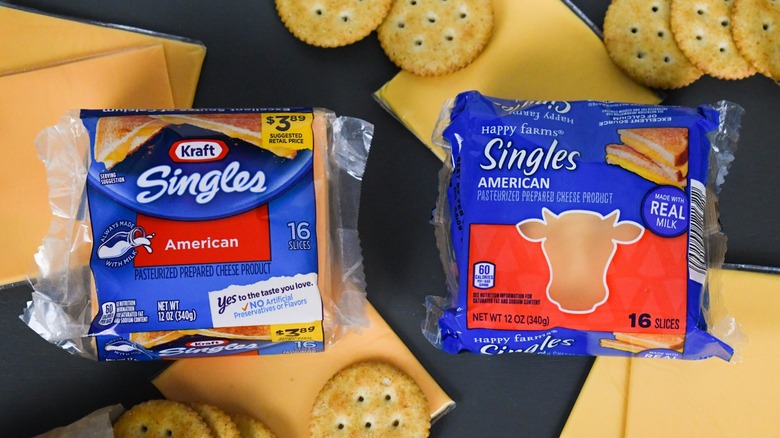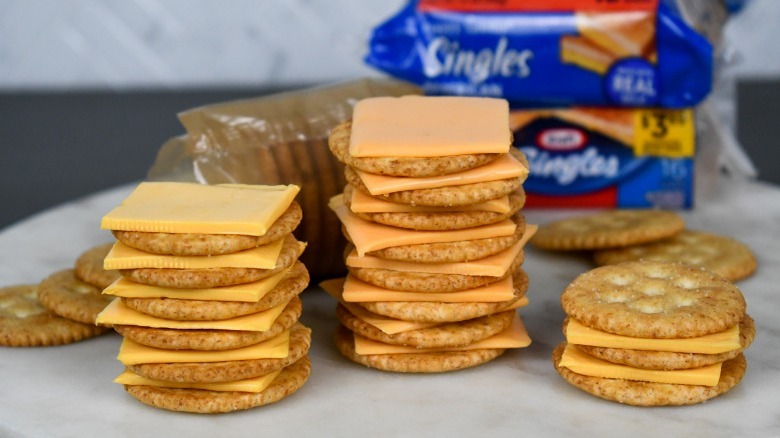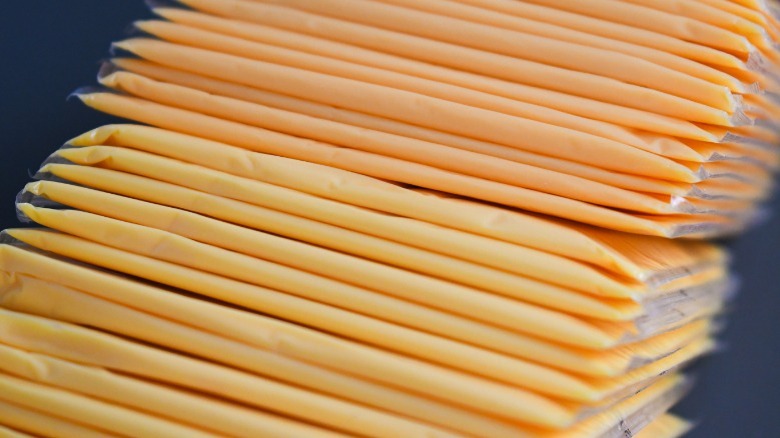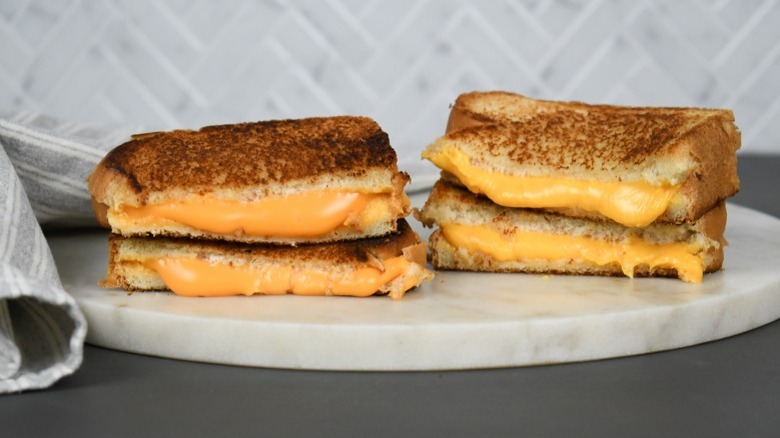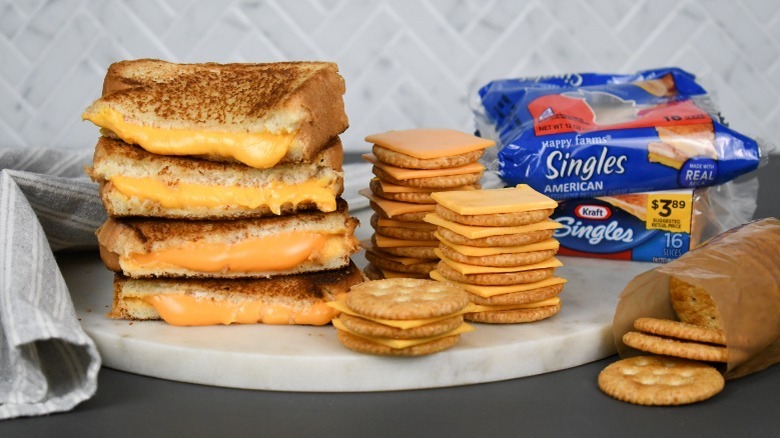Which Is Better: Kraft Singles American Slices Or The Aldi Brand?
When you think of American cheese, there's a good chance Kraft is the first brand that comes to mind. This is understandable since Kraft was the first brand to produce the processed cheese product that we know and love as "American" cheese in the U.S. over 100 years ago. It also might be just one of a few recognizable brand names that are available at your local grocery store. According to Statista, Kraft is the biggest name in American cheese, followed by generic store brands, Velveeta (which is also owned by Kraft but recognized as its own product by most consumers), Borden, Land O'Lakes, and then Boar's Head. With so many producers in the American cheese game, it's likely that you've tried a few different slices.
If you're familiar with Aldi Supermarkets, you already know that the grocer sells its own version of store brand groceries. Aldi's products often rival the name brand competition in taste, not to metnion for a fraction of the price you'd find at a typical grocery store. Given that there's such a large market for American cheese, it only makes sense that Aldi would create a store brand version of the stuff to compete with the bigger brands like Kraft.
But how does the Aldi store brand compare in terms of price, nutrition, and taste? We picked up a pack of Kraft American singles as our control and a pack of Aldi's American cheese singles, all to find out what the differences are, if any.
Cost and size comparison
For the sake of uniformity, we picked up packages that each contained 16 slices of cheese. The package of Kraft American singles has $3.89 printed directly on the label as the product's "suggested retail price", which most grocery stores seem to abide by. We couldn't find a price printed on the Happy Farms packaging, but it rang up at $1.99 before taxes — that's 49% less than the Kraft package. Each package weighs 12 ounces, too, so you're not getting any less product with the Happy Farms brand American cheese.
Now, $3.89 doesn't seem like an unreasonable amount to pay for 16 slices of cheese. After all, that's only about .24 cents per slice. And if you're making sandwiches at home, there's still a good chance you're saving money compared to buying your sandwich at a deli or eating out. But when presented with the option to pay just .12 cents per slice, it might be hard to turn down the discount for a comparable product — especially if your household goes through lots of sandwiches and American cheese snacks daily.
Kraft also sells packages of 24 slices and larger-format double packs with 32 slices, but the price is similarly scaled up. If you're only picking up one package of cheese now and then, you probably won't see much of a difference, budget-wise. But if American cheese is a staple on your grocery list, the savings will likely add up quickly when you opt for the Aldi brand.
Nutrition comparison
While most American cheeses are relatively the same, we took a look at the nutrition facts of both the Kraft and Happy Farms American cheeses to see if one brand stood apart from the other. Both brands specify one slice of cheese as a serving, and each serving weighs an identical 21 grams. Furthermore, each serving of both varieties of American cheese is 60 calories. Looking at the other metrics didn't provide much of a divide between the two brands either. The Happy Farms cheese slice contains .5 more grams of fat and 30mg more sodium. The nutritional values of cholesterol, carbohydrates, and protein are the same for both slices.
Where things get a little more interesting is when it comes to the ingredient list. Kraft specifies "cheddar cheese" as the first ingredient, where Happy Farms specifies "American cheese". Both of those cheeses are made with milk, culture, salt, and enzymes, but we're not entirely sure what differentiates the two otherwise.
The Kraft American cheese goes on to list skim milk followed by milkfat, where the Happy Farms American cheese lists water. Both include milk protein concentrate and whey, and the Happy Farms includes the addition of cream, which we assume balances the water further up on the ingredient list. The Kraft slices also include annatto and paprika extract for color, though we were curious if they would contribute to the taste. Ultimately, none of these ingredient combinations seem to make a difference in the final nutritional values.
Taste comparison
The first thing you might notice if you were looking at each slice of cheese right next to each other is that the Kraft American cheese is slightly more orange in color than the yellower Aldi brand American cheese. With that being said, color is not necessarily an indication of flavor, since the color is added for visual appeal and isn't a byproduct of the actual cheese-making process. Each slice is the same size and thickness, while both are tightly wrapped for freshness.
Since we're big fans of just about every kind of cheese, we had no problem popping an unadorned slice of cheese into our mouths to try and decipher any subtle differences between the two brands. The slightest of variations was only really noticeable because we were tasting both kinds of cheese at the same time. We noticed that the Kraft cheese has a slightly stronger cheese flavor, while the Aldi brand was slightly creamier. Both American cheese slices tasted great and we'd gladly accept whichever was given to us. Essentially, both of the slices tasted the same. Unless you're doing a side-by-side comparison, we think it's very unlikely that you or any picky family members will notice any major differences between the brands.
Taking it further, we stacked the slices with a few Ritz crackers, both for testing purposes and as a mid-afternoon snack. With a little more going on flavor-wise, it was even harder to tell the two apart, and both were enthusiastically eaten.
The grilled cheese test
Just to be extra thorough in this taste test, we fired up the stove and made some grilled cheese sandwiches to test the melting capabilities of each brand of American cheese. No one likes an unmelted rubbery slice on their grilled cheese sandwich, after all, so we wanted to make sure that the Aldi brand wouldn't let us down during this test. We made the sandwiches the classic way, with a pad of butter and white bread in a skillet on the stovetop. We loaded up each sandwich with a whopping three slices of cheese. We understand that such an amount might be a bit much for some people, but we really wanted to see what level of ooey-gooey melty cheesiness we could get out of both the Kraft and Aldi cheeses.
The first sandwich was made with the Kraft American singles, which melted as expected, with a lovely little stretch as we pulled the sandwich halves apart. The next sandwich was then made with the Happy Farms American singles. It took slightly longer to get the sandwich to the ideal melty stage — about another minute on the skillet, all told — but the result was equally gooey and satisfying. All of the minor flavor differences we noticed during the other methods of tasting still applied when eating the grilled cheese sandwiches. The Kraft singles were ever so slightly cheesier, while the Aldi brand singles were a touch creamier.
Overall winner
We think there's a good chance that, if you bought the Aldi brand American cheese and started slipping it into sandwiches and snacks without telling anyone in your household, there's a high probability that the person enjoying it won't know it's not Kraft. That's not to mention the fact that you can buy two packs of the Happy Farms cheese from Aldi for about the same price as one pack of Kraft from a different grocery store. And consider the fact that, the more you use the Happy Farms brand, the more money you're likely to save. You could potentially save up that extra cash for more deli meats or some fancy crackers.
Since there isn't a significant enough difference in taste and a negligible nutritional difference, the Happy Farms American cheese singles from Aldi are the winner in this matchup almost entirely based on the price difference. And for all you're saving when buying this cheese, you can find more ways to use it than in sandwiches alone. We're big fans of stirring a few slices into a pot of homemade macaroni and cheese, for instance, or melting some on top of vegetables. They're also ideal for Philly cheesesteaks and classic cheeseburgers, especially when you're tasked with feeding a crowd.
